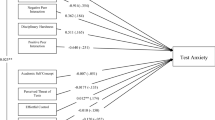Abstract
Children differing in test anxiety level were observed in two art classes, one immediately preceding a classroom examination, the other when no examination was expected. The observational analyses indicated the following: (a) When an examination was expected there were general increases both in children's task orientation and in their concern with other's evaluations, and a decrease in general activity level. It was suggested that future research examine the effects of additional situational variables on children's classroom behaviors, (b) Highly test-anxious children were generally hardworking and inactive. They reacted to examination expectancy with a decrease in task orientation, reduction in communications, and attentional constriction. Less anxious children reacted to examination expectancy by working harder, eliminating task-irrelevant behaviors, and seeking feedback. These results were interpreted as supporting a cognitive theory of test anxiety.
Similar content being viewed by others
References
Allen, G. J. Effectiveness of study counseling and desensitization in alleviating test anxiety in college students.Journal of Abnormal Psychology, 1971,77, 282–289.
Barnard, J. W., Zimbardo, P. G., & Sarason, S. B. Anxiety and verbal behavior in children.Child Development, 1961,32, 379–392.
Barnard, J. W., Zimbardo, P. G., & Sarason, S. B. Teachers' ratings of student personality traits as they relate to I.Q. and social desirability.Journal of Educational Psychology, 1968,59, 128–132.
Blishen, B. R. The construction and use of an occupational class scale.Canadian Journal of Economics and Political Science, 1958,24, 519–531.
Cox, F. N. Some effects of test anxiety and presence or absence of other persons on boys' performance of a repetitive motor task.Journal of Experimental Child Psychology, 1966,3, 100–112.
Cox, F. N. Some relationships between test anxiety, presence or absence of male persons, and boys' performance of a repetitive motor task.Journal of Experimental Child Psychology, 1968,6, 1–12.
Davidson, K. S., & Sarason, S. B. Test anxiety and classroom observations.Child Development, 1961,32, 199–210.
Easterbrook, J. A. The effect of emotion on cue utilization and the organization of behavior.Psychological Review, 1959,66, 183–201.
Hill, L. Relation of test anxiety, defensiveness, and intelligence to sociometric status.Child Development, 1963,37, 767–776.
Holroyd, K. A. Cognition and desensitization in the group treatment of test anxiety.Journal of Consulting and Clinical Psychology, 1976,44, 991–1001.
Liebert, R. M., & Morris, L. W. Cognitive and emotional components of test anxiety: A distinction and some initial data.Psychological Reports, 1967,20, 975–978.
Lighthall, F., Ruebush, B., Sarason, S. B., & Zweibelson, I. Change in mental ability as a function of test anxiety and type of mental test.Journal of Consulting Psychology, 1959,23, 34–38.
Little, S., & Jackson, B. The treatment of test anxiety through attentional and relaxation training.Psychotherapy: Theory, Research and Practice, 1974,11, 175–178.
Meichenbaum, D. Cognitive modification of test anxious college students.Journal of Consulting and Clinical Psychology, 1912,39, 370–380.
Mischel, W. Toward a cognitive social learning reconceptualization of personality.Psychological Review, 1973,80, 252–283.
Morris, L. W., & Liebert, R. M. Effects of anxiety on timed and untuned intelligence tests.Journal of Consulting and Clinical Psychology, 1969,33, 240–244.
Phillips, B. N., Martin, R. P., & Meyers, J. Interventions in relation to anxiety in school. In C. D. Spielberger (Ed.),Anxiety: Current trends in theory and research (Vol. 2). New York: Academic Press, 1972.
Sarason, I. G. Experimental approaches to test anxiety: Attention and the uses of information. In C. D. Spielberger (Ed.),Anxiety: Current trends in theory and research (Vol. 2). New York: Academic Press, 1972.
Sarason, I. G. Test anxiety, attention, and the general problem of anxiety. In C. D. Spielberger & I. G. Sarason (Eds.),Stress and anxiety (Vol. 1). Washington, D.C.: Hemisphere Publishing, 1975.
Sarason, S. B. The measurement of anxiety in children: Some questions and problems. In C. D. Spielberger (Ed.),Anxiety and behavior. New York: Academic Press, 1966.
Sarason, S. B., Davidson, K., Lighthall, F., & Waite, R. Classroom observation of high and low anxious children.Child Development, 1958,29, 287–295.
Sarason, S. B., Davidson, K. S., Lighthall, F., Waite, R., & Ruebush, B. K.Anxiety in elementary school children. New York: Wiley, 1960.
Wachtel, P. L. Anxiety, attention and coping with threat.Journal of Abnormal Psychology, 1968,73, 137–143.
Wine, J. Test anxiety and direction of attention.Psychological Bulletin, 1971,76, 92–104.
Winer, B. J.Statistical principles in experimental design (2nd ed.). New York: McGraw-Hiil, 1971.
Zweibelson, I. Test anxiety and intelligence test performance.Journal of Consulting Psychology, 1956,20, 479–481.
Author information
Authors and Affiliations
Additional information
This research was supported by Canada Council Grant No. S71-0272.
Rights and permissions
About this article
Cite this article
Wine, J.D. Test anxiety and evaluation threat: Children's behavior in the classroom. J Abnorm Child Psychol 7, 45–59 (1979). https://doi.org/10.1007/BF00924509
Revised:
Issue Date:
DOI: https://doi.org/10.1007/BF00924509




